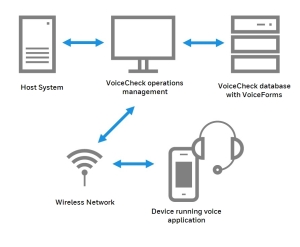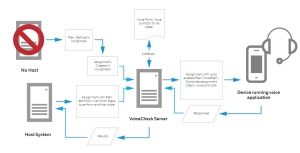Android Application
Supported Environments
| Android | |
|---|---|
| Operating System | Android 11 |
| Languages | English (US), Japanese, Spanish (Latin America), Spanish (European), German, French (Canadian), French (French) , Dutch (Netherlands). |
| Devices | The application will run on devices using Android 11. Refer to the list below for details. |
| Headsets | Honeywell SRX3 |
Supported Honeywell Android Devices
- Honeywell CT30XP with Android 11
- Honeywell CT40 with Android 11
- Honeywell CT40XP with Android 11
- Honeywell CT45 with Android 11
- Honeywell CT60 with Android 11
- Honeywell CT60XP with Android 11
- Honeywell CW45 with Android 12
Supported Features
The following languages and features are currently supported in the Voice Inspection Android application.
| Language | Feature | ||
|---|---|---|---|
| Trained Vocab | Spoken Long List | VoiceNotes / Memos | |
| English | ✔ | ✔ | ✔ |
| Spanish (Latin American) | ✔ | ✔ | ✔ |
|
Spanish (European) |
✔ | ✔ | ✔ |
| German | ✔ | ✔ | ✔ |
| French (Canadian) | ✔ | ✔ | ✔ |
| French (France) | ✔ | ✔ | ✔ |
| Japanese | ✔ | ||
| Dutch (Netherlands) | ✔ | ✔ | ✔ |
The Voice Inspection Android application does not currently support fractions or supervisor audio.
Spoken Long List
Users can train individual templates for list items using speaker independent functionality. Use the following guidelines when creating templates for spoken lists.
- List items may be 75 characters or less.
- Speaker-independent templates can only support up to two-digit numbers.
- List items with the following special characters can not be trained:
| ? < " : > + [ ] / ' *
Use caution when using other special characters such as a comma (,) as they can be spoken or unspoken and users might not know the difference.
For example, the list item “red, blue” would generate a template so that the user could speak “red blue”. However, if the list item was “red , blue” (with an extra space before the comma), the user would need to speak “red comma blue” for the list item to be recognized.
For performance reasons, a maximum of 20 untrained words per list is recommended and supported by the application.
Solution Overview
The Honeywell Voice Maintenance & Inspection Solution incorporates several components and applications that work together to deliver assignments to workers and record their results. The following diagram illustrates how the Honeywell Voice Maintenance & Inspection Solution works.
The Honeywell Voice Maintenance & Inspection Solution relies on data transmissions between a customer's host system, Honeywell VoiceCheck, and devices worn by technicians performing inspections.
Component Functions
- Host System: The host system generates assignment data and sends this data via web interface messages to VoiceCheck. After technicians perform the inspections, the host system receives the results from VoiceCheck and updates its data records.
- VoiceCheck: The VoiceCheck middleware product uses assignment data along with voice prompts defined in a VoiceForm to create voice plans. It transmits the voice plans to Honeywell Talkman devices and receives technicians' response data from the devices. Finally, it exports the inspection results back to the host system. VoiceCheck provides a web-based graphical user interface for management and tracking of inspection assignments.
- Android device running Voice Application: Android device running the Voice Inspection Android application. Users can view each inspection step on an Android device.
- Voice Inspection Application: This application runs on the Android device and controls all voice interactions between the technician and the assignment. The application translates incoming instructions into audible commands. It prompts technicians to perform each step in an inspection assignment and converts technician responses into output data that is sent back to VoiceCheck
- Wireless Headset: The SRX3 headset pairs with Android devices. The headset and microphone enable a technician to hear and respond to assignment instructions in a variety of industrial environments.
Data Mapping
Honeywell VoiceCheck provides a method to map data elements from a host system, identify and define specific work tasks, translate those tasks into voice prompts, prompt workers to perform the tasks and record results, and return the results to the host system.
If there is no host system present, VoiceCheck offers GUI pages for defining inspection plans and creating assignments. VoiceCheck uses a series of unique identifiers to perform the data tracking, merging, and parsing necessary to complete this process.
Inspection System Data Integration with or without a Host System

